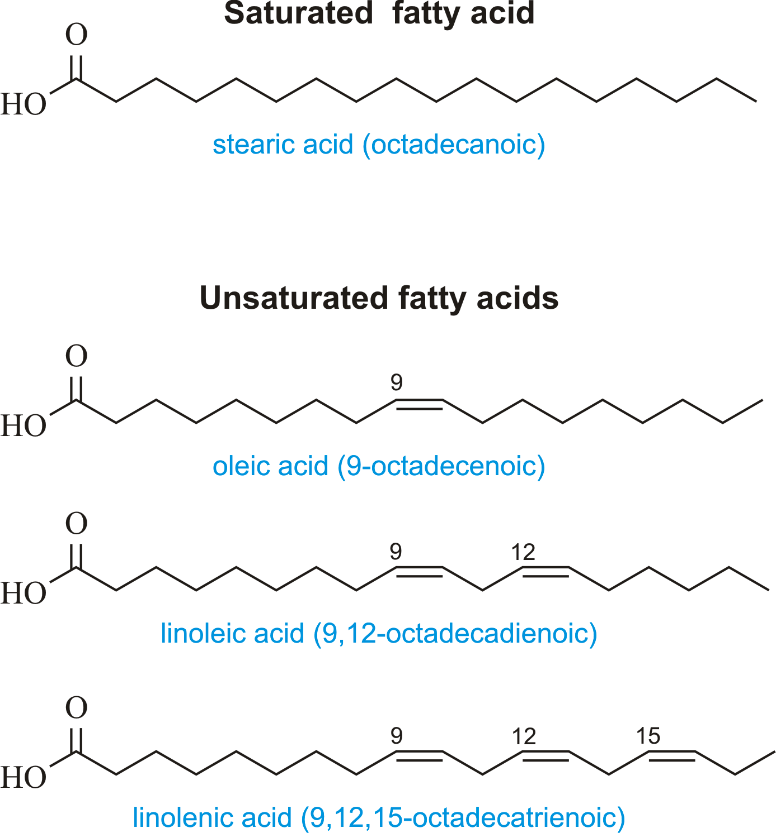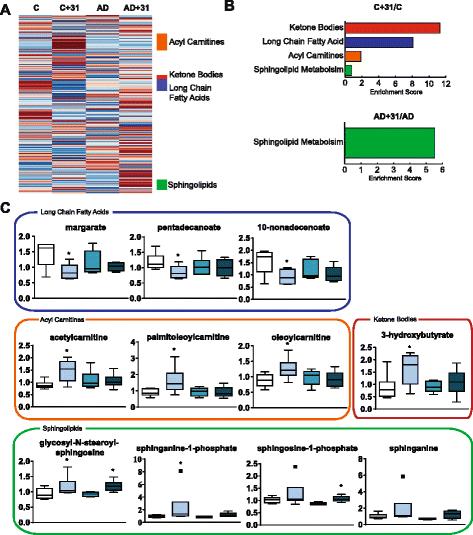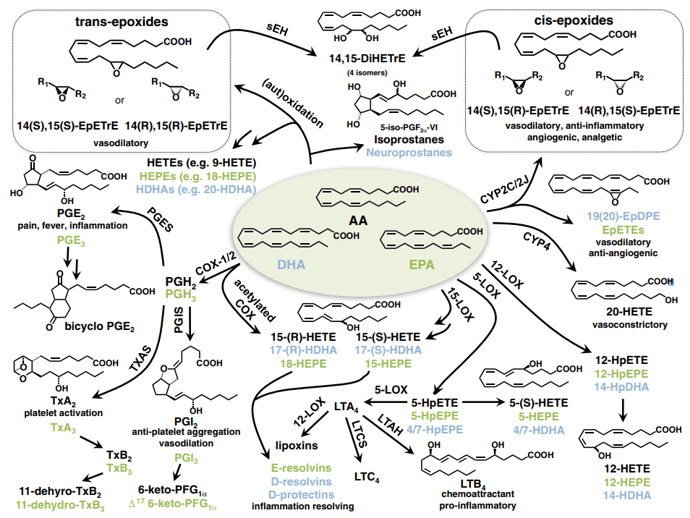Fatty acids are divided into saturated fatty acids and unsaturated fatty acids. Unsaturated fatty acids are divided into monounsaturated fatty acids and polyunsaturated fatty acids according to the degree of unsaturation.

Lipids are an important substance for the body to store and supply energy, as well as an important structural component of biofilms. Different types of fatty acids are related to a variety of metabolic diseases, such as diabetes, coronary heart disease and non-alcoholic fatty liver. Qualitative and quantitative analysis of fatty acids can promote research on related mechanisms and evaluate potential biomarkers of diseases. Changes in the interaction between the microbial flora and the host under different physiological conditions or environments may cause changes in fatty acid levels. The study of fatty acid changes in the microbial flora can also prompt relevant research information.
The fatty acids in the microbial flora can provide information on the structure of the microbial community and serve as a classification basis for identifying bacteria. It can also be used to study the nutritional status and metabolic activities of the community structure.
Food ingredients and products such as dietary supplements (such as fish oil) or drugs also contain various fatty acids. Fatty acid composition analysis can help you determine the identity and quantity of various fatty acids in these lipid products, and provide important product information.
According to the requirements of different molecular structures, Creative Proteomics provides a series of fatty acid analysis services based on GC-MS and LC-MS. In addition, we can also provide quantitative testing services for short-chain fatty acids. Our fatty acid analysis services can be applied to many industries, including biology, pharmaceuticals, agriculture, animal husbandry, food, nutrition, environment and other fields.
Fatty Acids Analysis Services in Creative Proteomics
- Fatty Acid Composition Analysis: Determination of the types and proportions of fatty acids present in a sample.
- Fatty Acid Profiling: Identification and quantification of individual fatty acids in complex mixtures.
- Fatty Acid Methylation Analysis: Conversion of fatty acids into their methyl ester derivatives for enhanced analysis.
- Fatty Acid Transmethylation: Conversion of complex lipid samples into fatty acid methyl esters for analysis.
- Fatty Acid Stability Testing: Evaluation of the stability of fatty acids under various conditions.
- Fatty Acid Oxidation Studies: Investigation of fatty acid oxidation pathways and products.
- Fatty Acid Synthesis Assays: Assessment of fatty acid synthesis rates and pathways in biological samples.
- Fatty Acid Biomarker Discovery: Identification of fatty acid biomarkers associated with specific diseases or physiological conditions.
- Fatty Acid Transport Studies: Analysis of fatty acid transport mechanisms in cells and tissues.
- Custom Fatty Acid Analysis Services: Tailored analysis services to meet specific research needs.
Fatty Acid Analysis Technology Platform
Gas Chromatography with Flame Ionization Detection (GC-FID): High sensitivity, reliable quantification, cost-effective, suitable for routine analysis.
Gas Chromatography with Mass Spectrometry (GC-MS): High sensitivity, specificity, structural elucidation, suitable for complex mixtures.
Liquid Chromatography with Mass Spectrometry (LC-MS): Excellent separation efficiency, sensitivity, accurate identification, versatility in method development.
 Figure 1. Fatty acids analysis service workflow.
Figure 1. Fatty acids analysis service workflow.
Types of Fatty Acids We Can Analyze
Fatty Acids by Length:
Saturated Fatty Acids
Unsaturated Fatty Acids
Others
The General Workflow for GC-MS-based Fatty Acid Analysis
Extraction
The first step is to extract fatty acids from the sample matrix, which can be achieved through different approaches:
- Liquid-liquid extraction (LLE): Commonly used methods include the Bligh-Dyer method (chloroform/methanol/water) and the MTBE method (methyl tert-butyl ether/methanol/water).
- Solid-phase microextraction (SPME): A solvent-free technique that involves adsorbing analytes onto a coated fiber, followed by thermal desorption in the GC inlet.
Derivatization
Fatty acids are typically derivatized to improve their volatility and thermal stability for GC analysis. Common derivatization methods include:
- Acid-catalyzed methylation: Using reagents like boron trifluoride (BF3) in methanol to form fatty acid methyl esters (FAMEs).
- Base-catalyzed methylation: Using bases like sodium methoxide or potassium hydroxide in methanol to form FAMEs.
- Other methods: Specialized methods like the use of trimethylsulfonium hydroxide (TMSH) or alkylchloroformates for derivatization.
Chromatographic Separation and Detection
- GC Column Selection: Columns like DB-23, DB-FFAP, and Omegawax are commonly used for fatty acid separation based on chain length and degree of unsaturation.
- Multidimensional GC: Employed for improved separation of complex fatty acid mixtures.
- Mass Spectrometric Detection: Provides structural information and enables identification and quantification of fatty acids.
- Internal Standards: Stable isotope-labeled or odd-chain fatty acids are used as internal standards for quantification.
Advantages of Our Fatty Acids Analysis Service
- Rich experience, can handle a variety of samples
- Developed advanced analysis platform based on GC-MS and LC-MS technology
- Fast turnaround time, about 1~2 weeks
- Provide flexible statistical analysis and bioinformatics analysis
Sample Requirements for Fatty Acids Analysis
- Serum / plasma ≥ 100 ul/sample
- Animal tissue: ≥ 50 mg/sample
- Saliva: ≥ 100 mg/sample
- Bile≥ 10 ul/sample
- Cell: ≥ 1×107
- Plant samples: ≥ 200 mg
- Yeasts, microorganisms, etc.: dry weight ≥ 200 mg
Quick-freeze in liquid nitrogen and store at -80°C, and send it on dry ice.
Please contact us for other sample types and dosages.
Fatty Acids Metabolism Data Analysis
| Content |
Description |
| Data Preprocessing |
- Raw Data Conversion: Convert raw data files to a suitable format.
- Peak Detection: Identify fatty acid peaks.
- Noise Reduction: Remove data noise.
- Alignment: Align peaks across samples. |
| Peak Annotation |
- Compound Identification: Match peaks with a reference database.
- Retention Time & Mass Accuracy Correction: Adjust for variations. |
| Quantification |
- Peak Integration: Calculate metabolite abundance.
- Normalization: Correct for variations.
- Internal Standards: Use if available. |
| Statistical Analysis |
- Univariate Analysis: Identify significant differences.
- Multivariate Analysis: Explore patterns and group samples. |
| Metabolite Pathway Analysis |
- Pathway Enrichment Analysis: Determine affected pathways.
- Network Analysis: Explore metabolite interactions. |
| Visualization |
- Heatmaps: Visualize metabolite abundance patterns.
- Volcano Plots: Display fold changes vs. significance.
- Pathway Maps: Diagram affected pathways. |
| Biological Interpretation |
- Biomarker Discovery: Identify potential biomarkers.
- Biological Insights: Understand the significance of changes. |
| Validation |
- Targeted Analysis: Validate findings with standards. |
| Reporting and Visualization |
- Generate Reports: Compile results, figures, and tables.
- Publication-Quality Figures: Create visualizations for publication. |
| Integration with Other Data |
- Combine metabolomics data with other omics data for a comprehensive view. |
Creative Proteomics offers several approaches to provide fatty acids analysis service and deliver precise and detailed data and analysis report. If you want to detect other metabolites but have not found them, you can tell us through the inquiry form, and our technicians will communicate with you.
Case: CAD-31: A Therapeutic Breakthrough for Alzheimer's Disease - Neuroprotective Mechanisms and Metabolomic Insights
Background:
The background of the study revolves around CAD-31, a potential therapeutic candidate for Alzheimer's disease (AD). It originates from a chemical structure derived from curcumin and was selected for its neuroprotective and neurogenic properties. The study aimed to investigate CAD-31's efficacy in a therapeutic AD model, its impact on neuroprotective activities, and its safety profile.
Samples:
The study primarily involved two sets of samples:
Animal Model: Transgenic mice (APPswe/PS1∆E9) with severe cognitive deficits and AD pathology at an advanced age (13 months) were used as the experimental subjects. These mice were administered CAD-31 to assess its therapeutic effects.
In Vitro Assays: Various in vitro assays were conducted using primary cortical cells, HT22 cells expressing the brain-derived neurotrophic factor receptor, primary cortical neurons, an in vitro ischemia model, and assays related to extracellular and intracellular Aβ toxicity. These assays helped evaluate CAD-31's neuroprotective properties.
Technical Methods:
Sample Collection: Cortex and plasma samples were collected from CAD-31-treated and control mice to assess CAD-31's impact on metabolite profiles.
Metabolite Extraction: Metabolites were extracted using methods like liquid-liquid or solid-phase extraction to isolate them from the biological samples.
Instrumentation: Advanced analytical instruments like LC-MS or GC-MS were used to analyze the extracted metabolites, detecting and quantifying a wide range of metabolites.
Data Acquisition: Comprehensive data on metabolite abundance, mass spectra, retention times, and peak intensities were generated during analysis.
Data Processing: Data underwent processing, including alignment, peak picking, and normalization to ensure data quality.
Metabolite Identification: Mass spectra and retention times were matched with known metabolites in databases for identification.
Statistical Analysis: Statistical tests like t-tests or ANOVA were used to identify significant changes in metabolite levels between CAD-31-treated and control groups.
Pathway Analysis: Pathway enrichment analysis revealed the impact of CAD-31 on significant metabolic pathways.
Visualization: Results were visualized using graphs and heatmaps to illustrate changes in metabolite profiles.
Interpretation: The study aimed to understand the physiological effects of CAD-31 exposure and identify potential biomarkers or affected metabolic pathways.
Results:
- CAD-31 effectively reversed cognitive deficits in the AD mouse model, restoring cognitive performance to levels comparable to age-matched control mice.
- CAD-31 did not significantly alter the levels of Aβ1–42, suggesting that its therapeutic effects were not primarily associated with Aβ reduction.
- RNA-seq analysis revealed that CAD-31 influenced gene expression, particularly in the AD model. It modulated pathways related to inflammation, synaptic function, oxidative phosphorylation, and AMPK signaling.
- CAD-31 treatment reduced inflammation by lowering proinflammatory markers like VCAM, RAGE, and clusterin. It also increased the expression of synaptic proteins and markers associated with neurogenesis and mitochondrial function.
- Metabolomic profiling indicated that CAD-31 had a significant impact on lipid metabolism, promoting the breakdown of fatty acids and enhancing energy metabolism, possibly through AMPK activation.
 Metabolic analysis of plasma shows effects on lipid metabolism.
Metabolic analysis of plasma shows effects on lipid metabolism.
Reference
- Daugherty, Daniel, et al. "A novel Alzheimer's disease drug candidate targeting inflammation and fatty acid metabolism." Alzheimer's Research & Therapy 9.1 (2017): 1-17.



 Figure 1. Fatty acids analysis service workflow.
Figure 1. Fatty acids analysis service workflow. Metabolic analysis of plasma shows effects on lipid metabolism.
Metabolic analysis of plasma shows effects on lipid metabolism.




